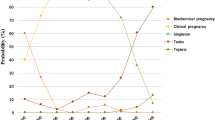Abstract
Objective
This study compares the efficacy of sequential clomiphene citrate (CC) + Gonadotropin to that of Gonadotropin alone with ultrasound monitoring.
Methods
It is a retrospective analytic study done on a total of 100 couples to compare two groups receiving CC + Gonadotropin and Gonadotropin alone for ovarian stimulation followed by intrauterine Insemination (IUI). We studied the cycle performance parameters. Cumulative pregnancy rates and ovulation rates were the primary outcomes. Results were analyzed following the intention-to-treat principle.
Results
There were no significant differences with respect to indications and the numbers of dominant follicles recruited. The endometrial thickness was significantly better in Gonadotropin-alone group (P < 0.05). Ovulation rate was better for CC + Gonadotropin at 95.91 %. Nine pregnancies were in the CC + Gonadotropin group (18.36 %) and 17 in Gonadotropin-alone group (33.3 %).
Conclusions
Significant differences in pregnancy rates and endometrial thickness were seen. Gonadotropin alone thus appears to give better results, but CC + Gonadotropin seems to be a cost-effective drug.
Similar content being viewed by others
References
Streda R, Stepan J, Zadrobilkova I, et al. Ovulation induction increases pregnancy rate during intrauterine insemination compared with natural cycles. Ceska Gynekol. 2007;72:397–402.
Brown J, Farquhar C, Beck J, et al. Clomiphene and anti-oestrogens for ovulation induction in PCOS. Cochrane Database Syst Rev. 2009;7(4):CD002249.
ASRM. The practice committee of the American Society for Reproductive Medicine Use of exogenous gonadotropins in anovulatory women: a technical bulletin. Fertil Steril. 2008;90:S7–12.
Crosignani PG, Somigliana E. Effect of GnRH antagonists in FSH mildly stimulated intrauterine insemination cycles: a multicentre randomized trial. Hum Reprod. 2007;22:500–5.
Ransom MX, Doughman NC, Garcia AJ. Menotropins alone are superior to a clomiphene citrate and menotropin combination for superovulation induction among clomiphene citrate failures. Fertil Steril. 1996;65(6):1169–74.
Dodson WC, Haney AF. Controlled ovarian hyperstimulation and intrauterine insemination for treatment of infertility. Fertil Steril. 1991;55(3):457–67.
Raslan A. Low dose hMG as a first choice for ovarian stimulation in IUI cycles. Evid Based Women’s Health Soc J. 2011;1(1):19–23.
Abdelazim I, Makhlouf H. Sequential clomiphene citrate/hMG versus hMG for ovulation induction in clomiphene citrate-resistant women. Arch Gynecol Obstet. 2013;287(3):591.
Atlay M, Gelisen O, Kocak M, et al. Comparison of a novel minimal stimulation protocol with clomiphene citrate plus recombinant follicle-stimulating hormone to recombinant follicle-stimulating hormone alone for ovulation induction: a prospective study. J Turkish-German Gynecol Assoc. 2007;8(4):397–401.
Akbary-Asbagh F, Heidar Z, Frozan-Fard F, et al. Evaluation of letrozole therapeutic effect in infertile women. Medica Iran. 2007;45(3):199–203.
Ganesh A, Goswami SK, Chattopadhyay R, et al. Comparison of letrozole with continuous gonadotropins and clomiphene-gonadotropin combination for ovulation induction in 1387 PCOS women after clomiphene citrate failure: a randomized prospective clinical trial. J Assist Reprod Genet. 2009;26(1):19–24.
Koli P, Anil M, Ramya NR, et al. Intrauterine insemination: a retrospective review on determinants of success. Int J Reprod Contracept Obstet Gynecol. 2013;2(3):311–4.
Van Rumste MM, Custers IM, van der Veen F. The influence of the number of follicles on pregnancy rates in intrauterine insemination with ovarian stimulation: a meta-analysis. Hum Reprod Update. 2008;14(6):563–70.
Thessaloniki ESHRE/ASRM-sponsored PCOS Consensus Workshop Group. Consensus on infertility treatment related to polycystic ovary syndrome. Hum Reprod. 2008;23(1):462–77.
Morad AWA, Farag MAE. Impact of letrozole on ultrasonographic markers of endometrial receptivity in polycystic ovary syndrome women with poor endometrial response to clomiphene citrate despite adequate ovulation. Middle East Fertil Soc J. 2014. 10.1016/j.mefs.2014.08.004.
ElKattan EA. Ultrasonographic markers of endometrial receptivity of letrozole and clomiphene citrate in unexplained infertile women. MEFS J. 2013;18:84–8.
Esmailzadeh Seddigeh, Faramarzi Mehbobeh. Endometrial thickness and pregnancy outcome after intrauterine insemination. Fertil Steril. 2006;88:432–7.
Cantineau AEP, Cohlen BJ. “Ovarian stimulation protocols (anti-oestrogens, gonadotrophins with and without GnRH agonists/antagonists) for intrauterine insemination (IUI) in women with subfertility.” Cochrane Database of Syst Rev. 2007;2:1–135. Article ID CD005356.
Acknowledgments
The authors thank the nursing and secretarial staff at the Indraprastha Apollo Hospital’s IVF unit for their assistance in the preparation of this manuscript.
Compliance with ethical requirements and Conflict of interest
Our study is retrospective data analysis as per ethics with consent of using stored data from treating doctor and hospital authority. The study is designed with an intension to treat patient and to find out which method is better for ovarian stimulation. There are no conflicts of interests that I should disclose, having read the instructions of submission and policies of journal.
Author information
Authors and Affiliations
Corresponding author
Rights and permissions
About this article
Cite this article
Sinha, S., Agrawal, N. Gonadotropin Alone is a Better Drug for Ovarian Stimulation than in Combination with Clomiphene in Intrauterine Insemination. J Obstet Gynecol India 66, 333–338 (2016). https://doi.org/10.1007/s13224-015-0686-9
Received:
Accepted:
Published:
Issue Date:
DOI: https://doi.org/10.1007/s13224-015-0686-9




